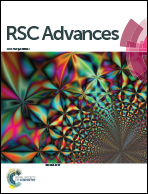Benzimidazolin-2-ylidene N-heterocyclic carbene complexes of ruthenium as a simple catalyst for the N-alkylation of amines using alcohols and diols†
Abstract
Simple air and moisture stable ruthenium complexes 1–3 and 3a were synthesized from readily available benzannulated N-heterocyclic carbene ligands (bimy = benzimidazolin-2-ylidene). These complexes were found to be efficient catalysts for the alkylation of amines using alcohols as alkylating agents. Catalysts 1, 2 and 3a gave excellent yields of up to 99% for the alkylation of various amines using benzylic and aliphatic alcohols at 130 °C for 18 h under solventless conditions. Catalyst 3a bearing both phosphine and carbene ligands gave excellent yields of up to 98% for the synthesis of heterocyclic amines by double alkylation of primary amines using linear diols. The practical utility of these catalysts was demonstrated for the synthesis of pharmaceutically important amines in a more environmentally benign way under solventless conditions.

- This article is part of the themed collection: Organic chemistry collection

 Please wait while we load your content...
Please wait while we load your content...